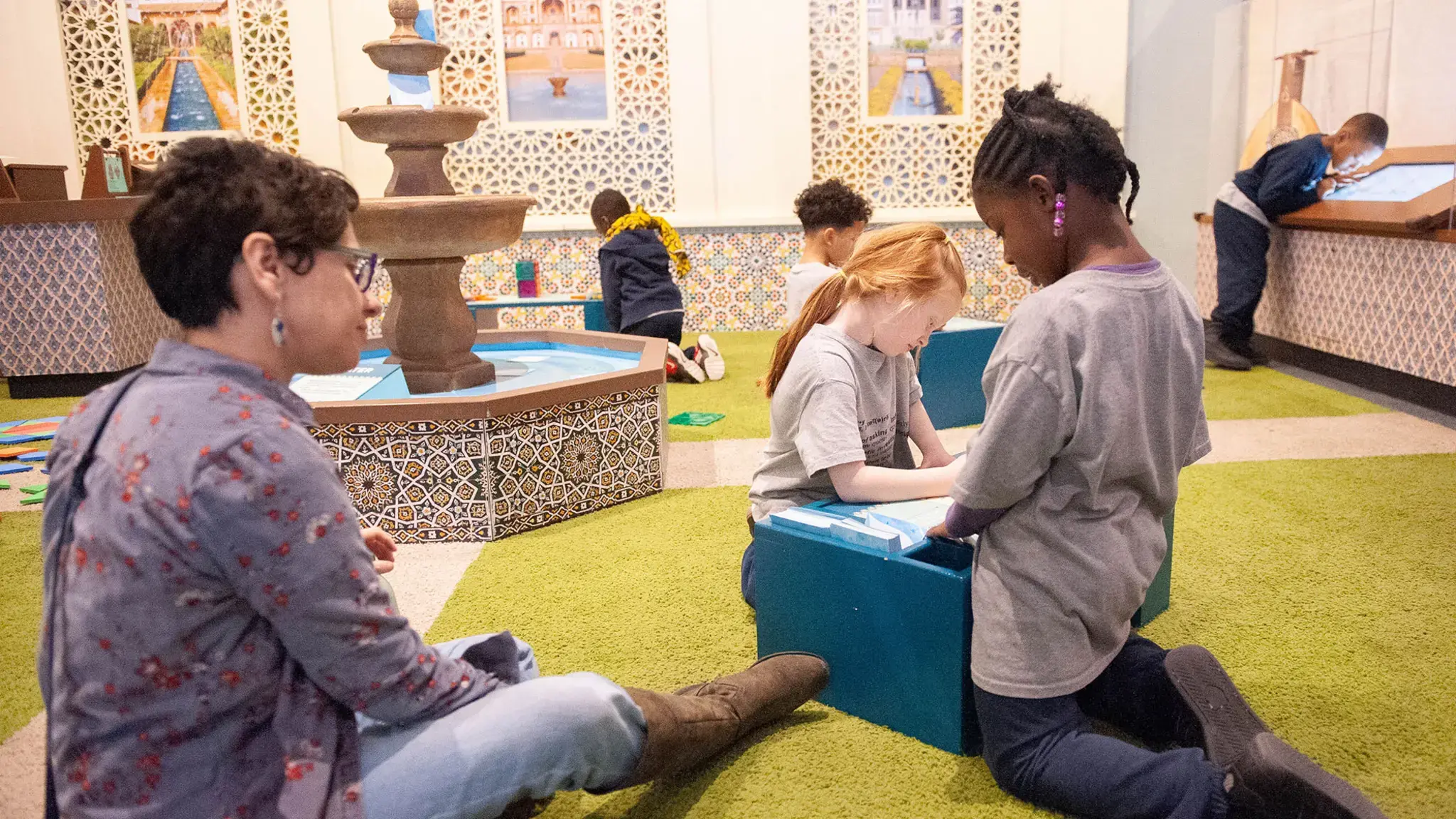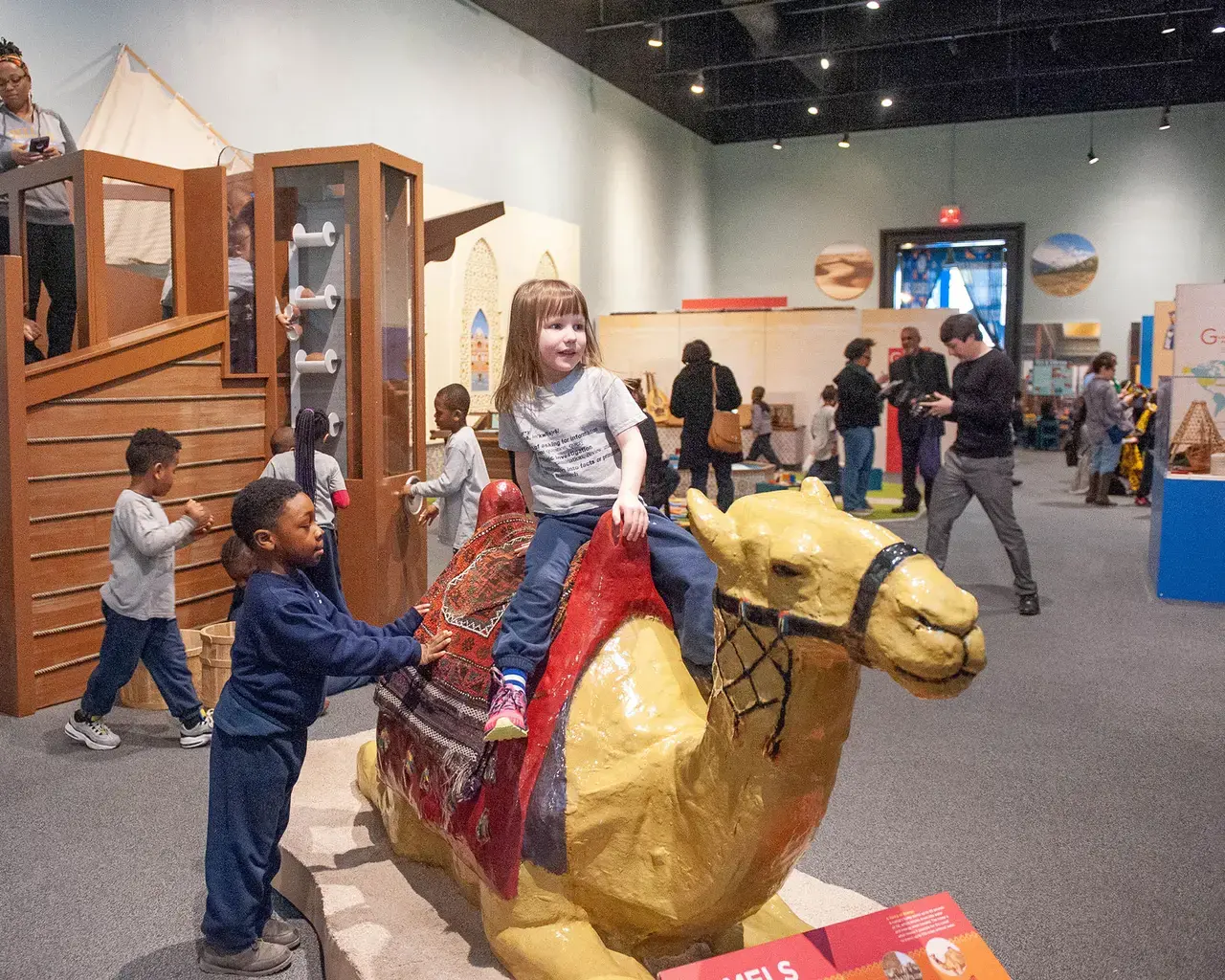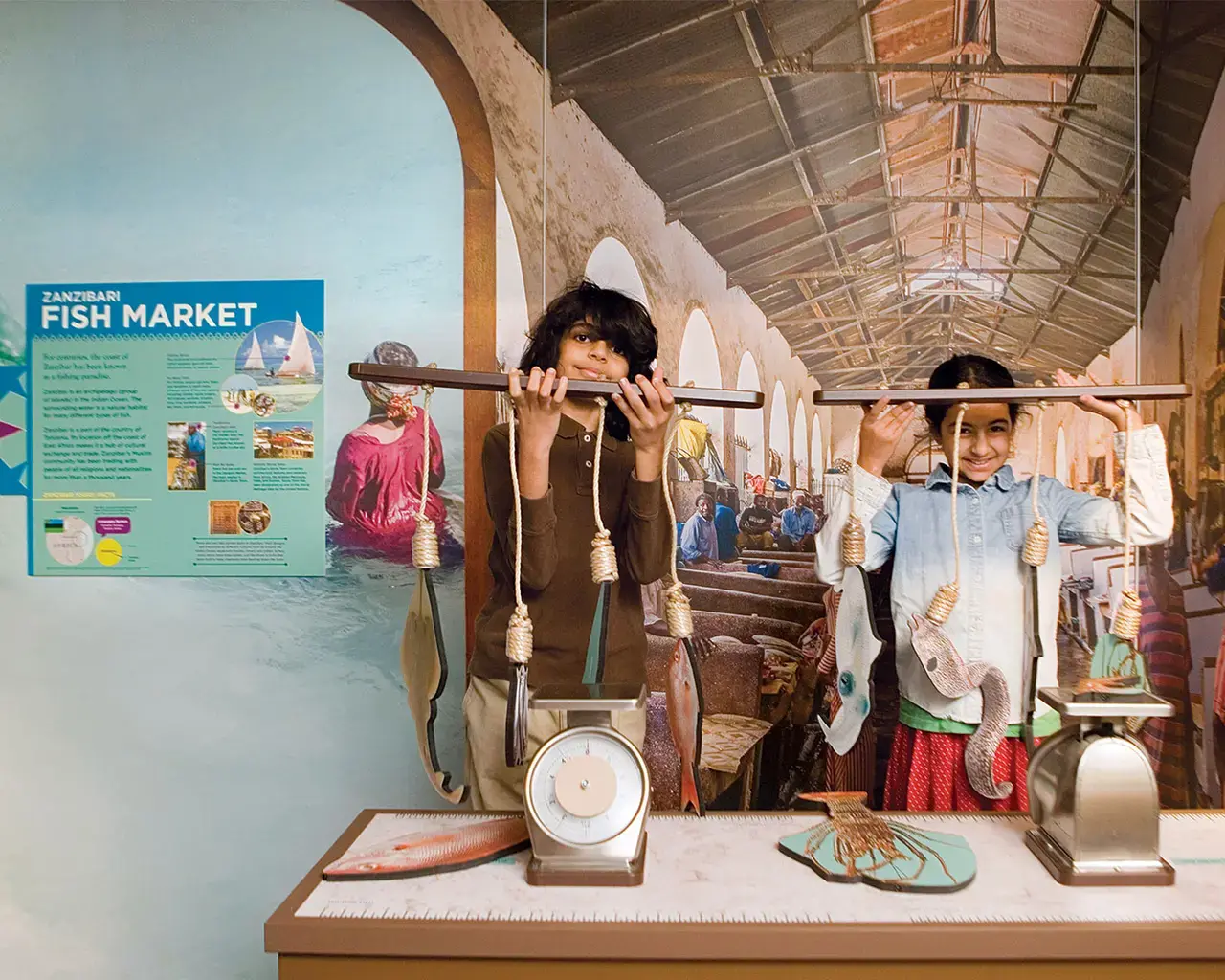How are cultural leaders and practitioners addressing artistic and organizational challenges today? And how do they make room for creative and institutional growth while facing shifting audience expectations and consumer behaviors? In this series of interviews with Center grantees, we offer a look inside the practices of many of Philadelphia’s leading cultural institutions and artists, their distinct characters, aspirations, and more.
Here, we speak with Patricia Wellenbach, president and CEO of the Please Touch Museum. With support from a Center Project grant, the Please Touch Museum is presenting America to Zanzibar: Muslim Cultures Near and Far, where children and adults can experience immersive 3D environments of Middle Eastern architecture and mosques, view historic artifacts and newly commissioned artwork created by Philadelphia-based Muslim artists, and hear personal stories from local Muslim families. Wellenbach discusses the collaborative process of creating the exhibition (on view through September 2019), what she has learned from the early response from both the Muslim community and the general public, and the Museum’s approach to fostering a healthy learning environment for young children.
America to Zanzibar: Muslim Cultures Near and Far is the first project under your new initiative to address contemporary social issues and represent Philadelphia’s culturally diverse populations. What are your hopes for this initiative? How is it influencing your approach to programmatic and organizational development?
PTM is committed to reflecting the visitors that we welcome every day and the city in which we reside. Philadelphia is a very diverse city and region; home to families of many cultures, faiths, and identities; and a major tourist destination to people from around the country and the world. Children today live in an increasingly interconnected world and are more aware at earlier ages of difference and the complexities of everyday life. Several years ago, we implemented programming that celebrates diversity at all levels, hosting festivals and programs with themes to include Juneteenth, Holi, Sukkot, Lunar New Year, Coming Out Week, and Pride.
America to Zanzibar (A to Z) is our most immersive investment in diversity programming. Our hope for A to Z is that children and families of Muslim culture will see their culture reflected in a positive way, one that recognizes the remarkable contributions that Muslim communities have made in our city and around the globe for centuries. We also hope that, through immersive programming that fosters exploration and discovery, children and families who are not familiar with Muslim culture would begin to understand and appreciate it. Our diversity programming is designed to be age-appropriate, to engage children and families in a wide array of experiences, and to promote respectful dialogue that we believe will foster acceptance of others.
I think the big “aha” for us was that we probably underestimated how this investment in diverse programming would engage and empower staff. The level of employee engagement in this work has been outstanding. As a result, the level of pride among staff about what we have achieved and how PTM is changing the dialogue around diversity, inclusion, and acceptance is palpable. You hear it in the conversations with staff and in their interactions with visitors. Candidly, two years ago when we first considered A to Z, it probably was a reach for us as an organization. Somehow, that did not seem to deter us. As we implemented more diverse programming in the past two years, even when we faced some opposition as we did with our Pride programming, we did not waver in our strategy and vision. A to Z was a project that every department, every staff member, and even the board owned and became actively involved with to assure its success. As a result, its impact throughout the organization has been deep, and I believe it will be long-lasting.
Why is it important for programming for children to engage with challenging contemporary subjects? Do you see a trend emerging in the field of early childhood education and/or a shift in the role museums can play in fostering dialogue and understanding?
In the past decade, museums in general began to engage their visitors and audiences in reflecting and learning about challenging contemporary issues. What has been remarkable to witness is the role that children’s museums have taken in this regard. There is no doubt that our increasingly interconnected world and the evolution of technology is influencing how, when, and where children are exposed to contemporary social issues.
Children’s museums are perceived as safe places for children and adults to come together to learn and explore. As such, many children’s museums are creating exhibits and experiential learning opportunities that foster dialogue on topics to include religion, war, immigration, incarceration, LBGTQ issues, health, and more. Research demonstrates that children as young as three can appreciate difference and begin to develop empathy, so it is quite appropriate for children’s museums to develop informal learning experiences that align with where their audience is developmentally. What is revealing is what happens in the intergenerational engagement that this type of museum experience provides. Adults often struggle with speaking with children at any age about complex issues. If children’s museums can, in a safe way, prompt adults to feel empowered to speak candidly with children about these types of issues, there is the potential for this type of dialogue to continue as children grow and mature.
How are you thinking about audience engagement and addressing the changing demographics and cultural consumption patterns that many cultural organizations currently face?
As a children’s museum that was founded by an educator whose focus was play-based learning, our mission may put us in a unique category and make us a bit different from other cultural organizations. Please Touch Museum experiences are developed with children in mind, but it is the adult that determines when and how often the child and/or family will engage in a museum experience, and that makes the calculus around what we do and why we do it very interesting.
Our core family audience may be urban- or suburban-dwelling, and often, there are differences in socio-economic status and cultural background. Certainly the family unit is widely disparate, but regardless of the family dynamic, we focus on creating opportunities for engagement in play-based learning that fosters creativity, collaboration, communication, and critical thinking. We are moving to more programming and exhibit engagement that is intergenerational and draws the adult into sharing the museum experience with the child. The diversity of programming is capturing the attention of our visitors, and we believe that is critical to audience development and engagement.
Our school programs are curriculum-based in STEM, STEAM, literacy, and creative and performing arts themes. They provide opportunity for evaluation, and we see a future where the programming ties directly to in-classroom experiences as a means to build scaffolded learning and support what is happening in the classroom.
For America to Zanzibar, you created an advisory council, involving both Muslim and non-Muslim community members in the project, and you commissioned new artworks from Muslim artists. Has this process influenced the way you think about collaboration? How do you create the conditions for successful collaborations and partnerships?
Our work with the advisory council for America to Zanzibar is directly tied to the success we are having with the exhibition. We knew from the very beginning that for the exhibition to be authentic and to have the impact we imagined, we needed people to actively partner with us every step of the way. Salima Suswell’s role as our project manager was an affirmation that we would honor our commitment to embrace community and learn from others. We invited highly respected individuals with backgrounds in education, religion, arts, culture, and civic engagement to be part of the advisory council. We were not afraid to listen and learn, and we gave the advisory council the opportunity to inform decisions on programming, audience engagement, and research.
When we opened the exhibit and welcomed over 300 people representing an array of cultures and faiths, I believe our advisory council was equally as proud of our accomplishment as the Museum staff and board were. Successful partnerships and collaboration are grounded in shared values, respect for others, and an unwavering commitment that we are working towards a collective outcome that is bigger than one individual or organization. That was central to our work with the advisory council, and the results clearly speak for themselves.
The opportunity for us to commission art, which was informed by children from the community, was just one of many ways in which we stretched and reached for excellence in our planning for A to Z. As the work began, we had no idea of how much we would achieve and how important this project would be, not just for the Museum but for the Muslim community. I learned that an elder imam said that A to Z has done more for the Muslim community and Muslim relations in our city than anything in the past 30 years. Who would have thought that was possible? Who would have thought that a children’s museum could embrace a culture and, through a bold investment in an exhibition, bring enlightenment to children and families from all cultures and faiths?
What is a particularly meaningful object or space in the Museum for you personally?
This question is like asking a parent which child is their favorite. I really don’t have a particularly meaningful object or space. It is likely to vary every day. I love to observe children and families as they experience the joy of accomplishment or discovery as they interact in an exhibit or engage in a program. What does bring great meaning to my life personally is walking through the Museum early in the morning or late in the day when there are no staff or visitors around. I reflect on the dual stewardship that I am responsible for: the 42-year legacy of the Please Touch Museum, which has brought the joy of learning to generations of children, and a landmark buildingwhose historical significance for our city and our country should not be underestimated. It is humbling to consider and energizes me to think about the future and all that we can still do.
How do you envision the Please Touch Museum in five years? In ten? How do you imagine it will be different than it is today?
Who knows what impact technology and innovation will have on learning in five or ten years? And so I expect much will be different in the Museum’s exhibits and programs. I often describe Please Touch Museum as a learning institution, and I remind myself that, every minute of every day, a child is brought into this world who, regardless of circumstances, deserves the opportunity to realize their full potential. So our role as a children’s museum should continue to be vitally important. Children are curious by nature, and in that curiosity is a freedom to explore and discover new things. Regardless of how the Museum may change, investing in children in their earliest years is going to be even more important. As a leading 21st-century children’s museum, we must innovate in how we empower children to be active and avid learners, to give them the confidence to try new things, and to embrace challenges. What I know for sure is that the importance of early childhood learning will continue to be instrumental in the future success of each child, their families and community, our city, and quite possibly the world.











